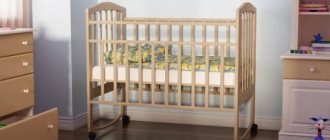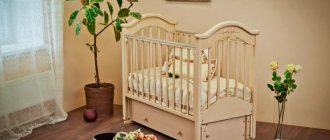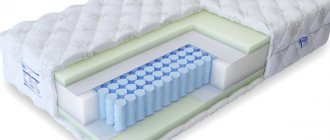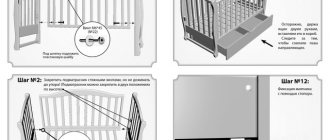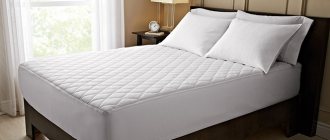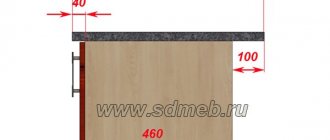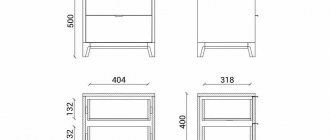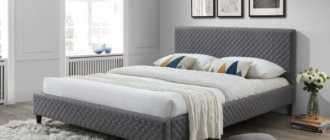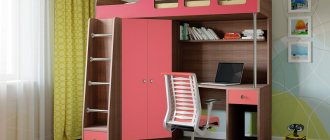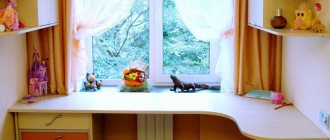When buying a children's bed, one of the main criteria is the dimensions of the furniture. Selecting the right model in size and height will provide your child with the comfort and safety that is important to him.
When planning to buy furniture for a child’s sleep, you need to pay attention to such parameters as the height of the children’s bed, its length and width. The variety of models presented in the store will make it easy to choose an option with suitable dimensions for the correct arrangement of a full-fledged sleeping place, depending on age.
Basic parameters for choosing a children's bed
Not only his comfort, but also his health directly depends on how correctly a bed is chosen for a child. When purchasing, experts suggest parents focus on the following parameters:
- Age appropriate
Depending on the age of the children, different requirements may be imposed on the sleeping place, and first of all, on its dimensions. The height of the bed for a child should allow him to easily get down and get into it on his own without the risk of falling, and the length and width should correspond to his height and build.
- Safety
Safe children's furniture is a high-quality assembly, durable and strong design, as well as the complete absence of components and elements that the child risks getting hurt or hit hard - such as noticeably protruding bases, sharp corners and lattice sides in which the baby's hand or leg can get stuck. . Also, such beds should not have complex mechanisms that children are unlikely to be able to handle on their own, and when purchasing, you must carefully check the selected model for damage, cracks and chips.
- Environmental friendliness
The quality of materials is another strict criterion in choosing a bed for a child. Responsible manufacturers use only raw materials that meet strict environmental safety requirements - their furniture is usually made from natural solid wood or high-quality MDF or plastic without dangerous additives, and only non-toxic hypoallergenic varnishes and paints are selected for painting. To be sure of the right choice, you can ask the seller for documents and certificates for the bed - the E0 or E1 marking indicated in them indicates that the model meets all the above requirements.
In some cases, adults select a bed based on the size of the children's room, color and design. These criteria are also relevant, but the comfort and health of the child must be taken into account first.
Frame material
Despite the fact that for the manufacture of any types of children's furniture, including bedroom furniture, the best material is natural wood (solid wood, boards, bars, slats), most budget options for cribs are made on the basis of chipboard (chipboard) or medium density fibreboard (MDF panels ).
Coniferous wood is usually used to make children's beds, but products made from hard wood - ash, maple, beech - are more preferable.
Quite popular are samples made in a combined version, when laminated chipboard or MDF panels are used for walls and panels, and load-bearing, frame structures are made of wooden blocks, boards or slats. Today on the children's furniture market there are quite a lot of combined models that combine metal and wood, wood and plastic, or all three of these materials at the same time. Thanks to this technique, it is possible to obtain samples of a fairly original design that have a very affordable price.
When choosing a specific model, you should pay attention to the design of the base for the mattress. The solid bottom used in some models, even if equipped with ventilation holes, cannot be considered the best option. A more acceptable design for the mattress base is considered to be slatted or sieve, which provides excellent ventilation of the mattress. When equipping a children's bed with an orthopedic mattress, in the vast majority of cases, a sieve bottom made of rounded, solid wooden slats is used.
When should you change your child's bed?
Sleeping places for children need periodic updating, and therefore sooner or later the child will need another bed. Furniture must be replaced in the following cases:
- The child grows up
This process is natural and inevitable, and therefore, from the moment the baby is born, it is necessary to plan to replace the bed in a few years. As children grow and develop, the dimensions of the furniture change according to the following principles:
- From 3 years.
For a young child, it is necessary to increase the length of the bed to 140-145 cm, while the height of the children's bed from the floor also changes by at least 30 cm upward. - 7-10 years.
For a primary school student, a length of 160 cm and a width of at least 80 cm will be required. The height can be left the same or increased by 10-20 cm if you plan to place drawers for linen or toys under the bed. - Children 10 years and older.
Schoolchildren and teenagers will be provided with comfort by a bed with a minimum size of 90x180 cm and a height of 50 cm. Adult single beds also have the same dimensions, so your child can choose an option in any model range. - There has been a sudden change in the child's height or weight
In this case, a change of bed will be required before moving to the next age stage. Selecting furniture based on standard criteria can be quite risky, so you should focus on individual parameters: if the child stretches out quickly, you need to add at least 30-35 cm to his height, and from 15 cm to his width.
- The child became uncomfortable
Inconvenience can be caused not only by changes in weight and height, but also by subjective reasons - because of the high sides he is unable to climb into the bed on his own, the low headboard does not allow him to get comfortable, or due to too active games in the room he often hits parts of furniture. In this case, it is important to select a model as soon as possible, based on the individual needs of the child, otherwise poor sleep quality will affect his well-being.
- The bed is damaged
If breaks and cracks appear on the body or base, parts of the bed become loose or fall off, replacement is necessary as soon as possible, and primarily for safety reasons.
Beautiful examples
The Ukrainian model EllipseBed 7 in 1, according to parents, has no disadvantages. Bed made of alder or beech. It has an original design, the walls are decorated with hearts. Available in different colors, from white to dark. The bottom can have three positions, and there is also a rocking mechanism and wheels with stoppers. Transforms from a crib to a children's table. On bunks with a diameter of 72x72 cm you can place the baby in any direction.
Unusual multifunctional model Sweet Baby Delizia Avorio with a pendulum made in Italy
It attracts attention with its laconic design, made of natural wood. Diameter 75x75 cm, when transformed it stretches to 125 cm
There is a pendulum mechanism, 3 lower positions. There are rollers that are loosely attached and do not have a stopper. Simultaneous use of wheels and pendulum is not possible. The cradle is poorly polished.
This multi-functional turquoise bed made from New Zealand pine isn't cheap, but it will last for generations. High-quality wood processing and material resistance to deformation will delight young parents.
Standards and sizes of children's beds
The dimensions of children's beds are determined not only by age, but also by the design of the models. Today in Moscow you can buy various options - but no matter which one suits the taste of parents and children, it is important first of all to pay attention to the sizes.
Children's beds from 0 to 3 years
Manufacturers offer models of various configurations for children from birth to 3 years. For a standard crib, clear dimensions are established - from 60x120 cm, the maximum height of the sides is 95 cm. If the sides are lattice, the permissible distance between the bars is 7.5 cm.
Playpen bed
Safe and functional bed models for babies, in which they can play and relax even as they grow older. As a rule, they have fully mesh or fabric sides with mesh windows on a lightweight metal frame. The recommended minimum dimensions of such beds are 120x70 cm.
Add-on bed models
A distinctive feature of side beds is a removable sidewall, in the absence of which it can be placed close to the parents’ sleeping place. As a rule, their dimensions are smaller than standard ones - width is about 55-60 cm, length - 90 cm, height - 30-50 cm, and the size of the sides is up to 80 cm. It is important that the height exactly corresponds to the same parameter of an adult bed in avoid injury and discomfort.
Transformable beds
Such models are a complex modular design, which, in addition to a bed, includes a chest of drawers, a changing table and drawers for linen. As the child grows, the sides are removed, the height of the base is adjusted from 30 to 50 cm, and the remaining modules turn into bedside tables and hanging shelves, without which the model for a baby transforms into a teenage bed. The dimensions of such furniture vary in the range of 160-200 cm in length and 60-80 cm in width, so a quality product can last 10-12 years, providing the child with the necessary comfort.
For preschoolers and schoolchildren
The sizes of bedroom furniture for preschool children and schoolchildren vary between 140-170 cm in length and 60-80 cm in width. In this case, the height of the head of the children's bed also plays an important role - it should protrude upward by at least 40 cm from the mattress, otherwise it will be uncomfortable for the child to settle down to sleep.
For teenagers
Teenage beds are almost the same size as adults - from 180 cm in length, from 80-90 cm in width with an average height of 50 cm. Buying a sliding bed can also be a reasonable solution, since the child continues to grow little by little until graduation.
Bunk beds
Children's bunk beds can be of two types:
- With upper sleeping and lower play area. The standard size of this model is 90x190 cm.
- With two sleeping areas. In this case, the length of the bed can be up to 200 cm and the width up to 110 cm.
The height of a bunk bed for children is a key selection criterion, which even affects the cost of products. Most models are made in the range of 1.5-1.8 m, although you can also find models 1.4 m high with a roll-out lower tier.
Custom beds
Models of non-standard beds include:
- Beds for twins
. Their standard size is 135x125 cm. Such beds are used until children turn 4-5 years old, after which they are changed to two single beds or a bunk model. - Designer models
. Beds in the form of cars, castles, ships, as a rule, have sleeping places that meet the standards. However, before purchasing, you must take measurements to be sure. - Beds of non-standard length
. Such models are often made to order for tall teenage children.
Cradles
This type is very popular among parents who want to create comfortable conditions for themselves and their children. Such a model can be equipped with an arc with toys, a visor, wheels and other elements, but the main feature is a manual or automatic motion sickness system.
Typically, such models are intended for babies up to 8-12 months, so their length does not exceed 85-95 cm and width 50 cm. When the baby is 8-12 months old, the crib will have to be changed to another.
The disadvantage of such models is that they do not have proper stability. This must be taken into account during operation.
A simple cradle that can independently rock a newborn, supporting a weight of up to 20 kg.
Tips for choosing a mattress, mattress pad, pillow, textiles
In addition to the bed, bedding, which is chosen according to certain criteria, is also responsible for a child’s healthy and restful sleep.
- Mattress
. In size, they must fully correspond to the dimensions of the sleeping place without deformation or the formation of cracks. The height of the mattress for a children's bed is no less important. If for babies this parameter is 6-8 cm, then with each age stage it can be increased by 2-3 cm. As for materials, orthopedists recommend fillers of moderate and high hardness. - Pillow.
Newborns do not require a pillow. However, as you grow, it is necessary to select options that ensure a healthy body position and comfort during sleep - not too hard and high, made from safe hypoallergenic materials. The pillow needs to be changed every 2-3 years. - Textile.
The best option is bed linen made from fabrics with a high content of natural cotton. At the same time, it is necessary to select it exactly according to the size of the pillow and blanket so that the pillowcase and duvet cover do not bunch up or roll down.
Obviously, the selection of a children's bed and bedding depends on many factors. That is why it is important to select furniture slowly, carefully studying each option for comfort, quality and safety. It’s also not worth saving on such things: good sleep ensures good health and proper development of the child.
SON.ru will help you with your choice
Our specialists are the best experts in matters of comfortable sleep and are always ready to help you. We are in touch and will answer all questions. The consultation is absolutely free.
Materials from which cribs are made
In the first months of life, the baby sleeps about 18 hours a day. Growing up, he begins to explore the world, tasting all objects. That is why everything that surrounds it must be made of safe materials - without harmful substances, pungent odor or taste.
Tree
Solid wood is perhaps the best option for the first crib. This is a durable natural material that allows air to circulate and looks very cozy. Most often, birch, alder, oak or beech are used for the production of children's furniture, which are highly resistant to mechanical damage. However, untreated wood absorbs moisture well, which can lead to its rotting, so wooden furniture is treated with special means. For cribs, safe water-based varnishes and paints are used, without lead and formaldehyde.
Rating of the best manufacturers
On the Internet you can find many ratings of crib manufacturers, most often they include the following:
- national teams: Krasnaya Zvezda, Lel, SKV, Brichiola, Antel, Papaloni;
- foreign: Pali, Wundermoebel, Bambolina, Valle.
A crib, changing table, bedside table, and separately purchased baby care products are much more expensive than a convertible bed that combines all of these items at once. It is worth noting that domestic manufacturers have long learned to make high-quality furniture, so their models very often lead the charts and are the highest in terms of price-quality ratio.
The versatility of a convertible bed will undoubtedly increase the comfort of a child's bedroom, making efficient use of space. Thanks to the wide range of models presented, it is easy to find exactly what suits your child.
The main advantages during operation are the lightness and quietness of moving parts.

